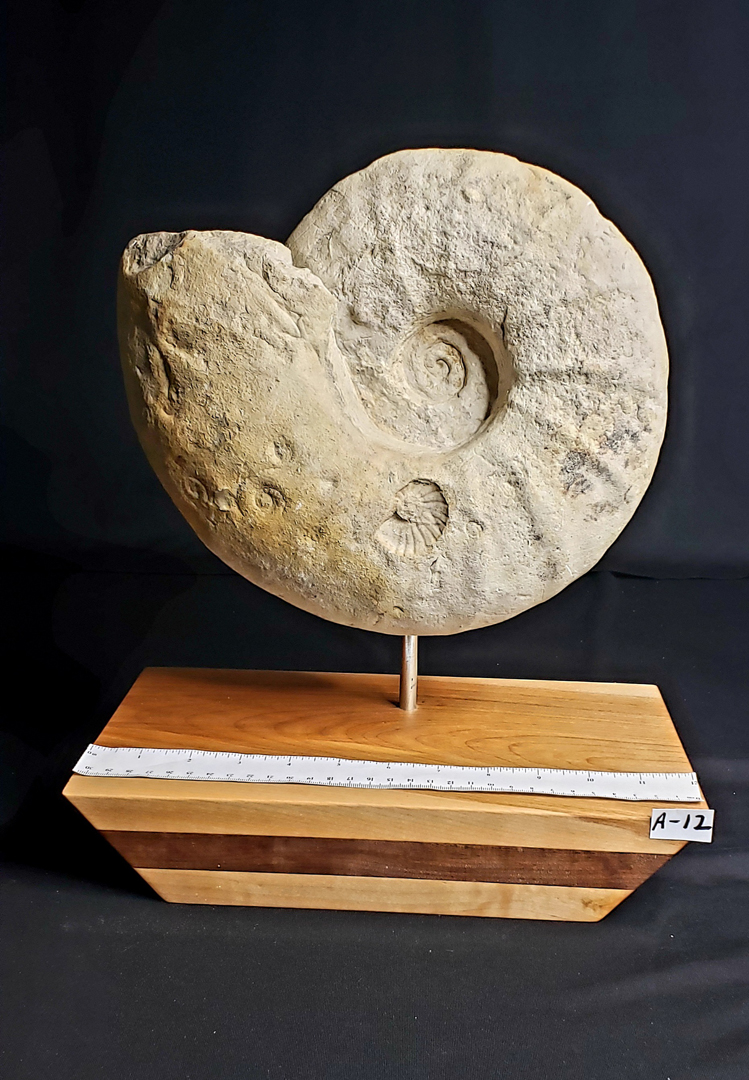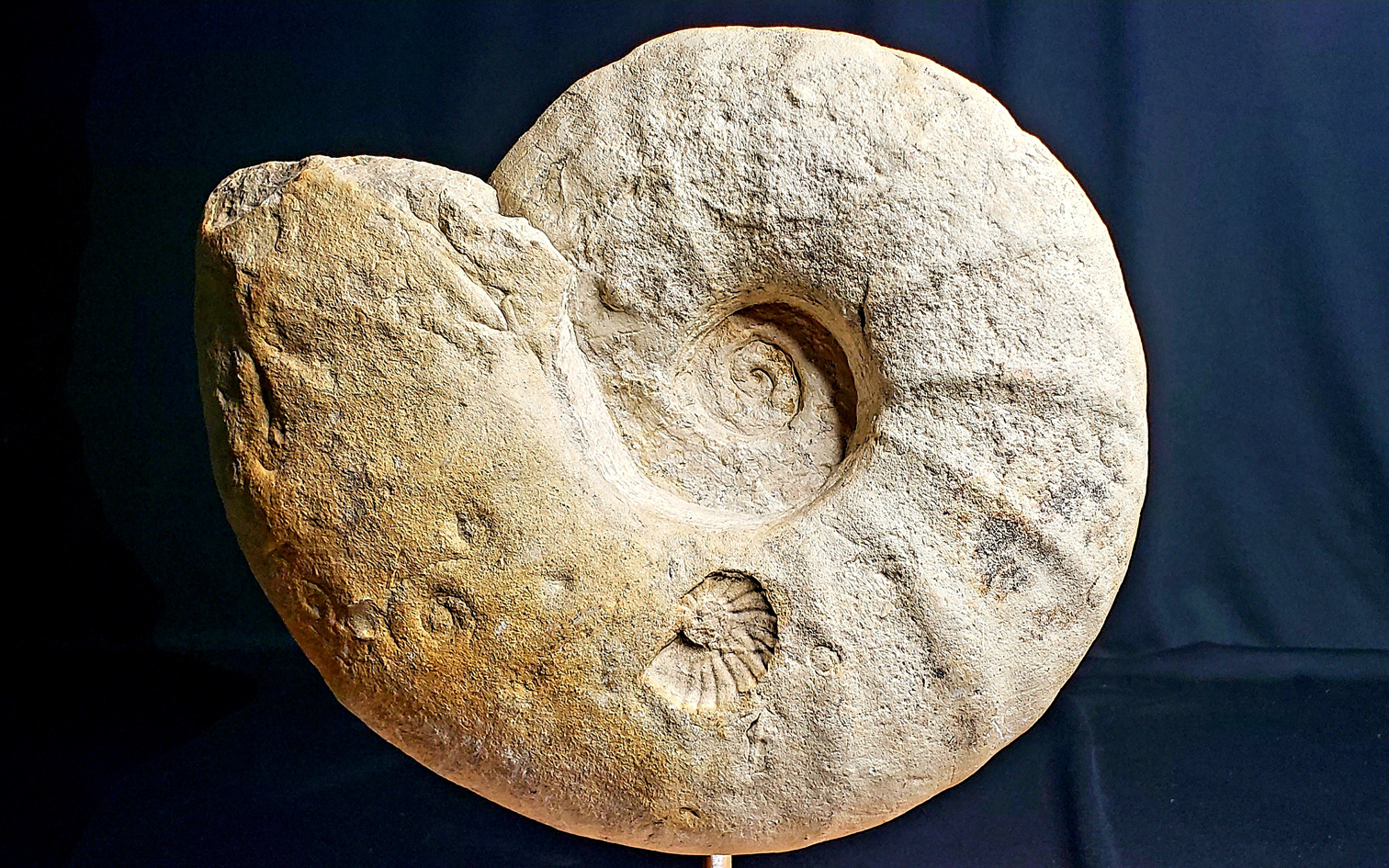
LK Ammonite Eopachydiscus
Eopachydiscus marcianus
Duck Creek Fm. (Lower Cretaceous - Albian)
Pecos County, Texas
Duck Creek Fm. (Lower Cretaceous - Albian)
Pecos County, Texas
This example is mounted on a custom base to create a handsome display. The display base is 12 x 7 inches. The ammonite is 10 inches across its largest dimension. The inner-most whorls have some restoration. The ammonite is easily removable from the mounting. These specimens make excellent display items for home or cabinet. They are also wonderful ideas for presentation awards or gifts.
Eopachydiscus is a medium to large-sized ammonite that is characterized by its moderately involute and compressed high oval whorl. They display ribs that are very gently curved and cross the rounded venter swinging forward in the crossing. Ribs are elevated in the young but may fade to obscurity in some adults. Whorls are few in number. The suture is a major identification feature and is composed of a trifid lateral lobe and numerous auxiliaries all of which are minutely frilled.
At the type locality on Duck Creek, the formation consists of about 120 feet of limestone and marl, as follows: (a) Basal 40 feet of thin strata of limestone (up to 1 foot each) and thicker limy marl strata, forming the creek bluff north of the railway; Elobiceras, Hamites and many other fossils occur in the basal part, overlying the Kiamichi with Gryphaea navia and Oxytropidoceras (Adkinsites) belknapi; the entire thickness contains Desmoceras and Bendanticeras and Pervinquieria, and at the top there is a prominent zone of Epiaster whitei Clark. (b) A medial 40 feet is clay, with several species of Pervinquieria, Gryphaea, echinoids, and limonite fossils in two or three layers (this is the type locality of those described by Scott, (1388). (c) An upper 40 feet of clay, blue shale, and a few, scattered, thin, limy, seams, is exposed in the railway cuts southeast of the main creek cuts; these cuts contain many fossils, including pyrite micromorphs (Pervinquieria and others). At Fort Stockton, it is about 48 feet thick; at Kent, 50 feet; at El Paso, about 100 feet at Sierra Prieta, about 25 feet. The division into an upper, more marly, and a lower, more limy, portion persists from Red River to at least Johnson County.
In Pecos County the Duck Creek is about 20 feet thick and contains a prominent ammonite fauna dominated by Schloenbachia and Eopachydiscus. The Duck Creek appears to be conformable to the underlying Kiamichi Formation. The formation is a soft chalky , nodular, whitish, argillaceous limestone rich in fossils. The basal ledge that caps the Kiamichi contains a prominent of fossil oysters and the echinoid Macraster.
Eopachydiscus is a medium to large-sized ammonite that is characterized by its moderately involute and compressed high oval whorl. They display ribs that are very gently curved and cross the rounded venter swinging forward in the crossing. Ribs are elevated in the young but may fade to obscurity in some adults. Whorls are few in number. The suture is a major identification feature and is composed of a trifid lateral lobe and numerous auxiliaries all of which are minutely frilled.
At the type locality on Duck Creek, the formation consists of about 120 feet of limestone and marl, as follows: (a) Basal 40 feet of thin strata of limestone (up to 1 foot each) and thicker limy marl strata, forming the creek bluff north of the railway; Elobiceras, Hamites and many other fossils occur in the basal part, overlying the Kiamichi with Gryphaea navia and Oxytropidoceras (Adkinsites) belknapi; the entire thickness contains Desmoceras and Bendanticeras and Pervinquieria, and at the top there is a prominent zone of Epiaster whitei Clark. (b) A medial 40 feet is clay, with several species of Pervinquieria, Gryphaea, echinoids, and limonite fossils in two or three layers (this is the type locality of those described by Scott, (1388). (c) An upper 40 feet of clay, blue shale, and a few, scattered, thin, limy, seams, is exposed in the railway cuts southeast of the main creek cuts; these cuts contain many fossils, including pyrite micromorphs (Pervinquieria and others). At Fort Stockton, it is about 48 feet thick; at Kent, 50 feet; at El Paso, about 100 feet at Sierra Prieta, about 25 feet. The division into an upper, more marly, and a lower, more limy, portion persists from Red River to at least Johnson County.
In Pecos County the Duck Creek is about 20 feet thick and contains a prominent ammonite fauna dominated by Schloenbachia and Eopachydiscus. The Duck Creek appears to be conformable to the underlying Kiamichi Formation. The formation is a soft chalky , nodular, whitish, argillaceous limestone rich in fossils. The basal ledge that caps the Kiamichi contains a prominent of fossil oysters and the echinoid Macraster.





